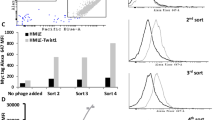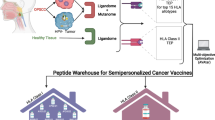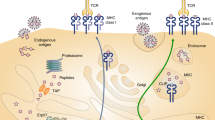Abstract
To gain insight into the mechanisms of molecular recognition and humoral immune response in ovarian cancer, we used fingerprinting, a phage display-based combinatorial selection to isolate peptide ligands to tumor-related antibodies present in ascites from patients with advanced disease. First, we have isolated a consensus motif (sequence CVPELGHEC) in 86% of the peptides screened; this enriched motif was selected from a total of 108–109 unique random sequences present in the library. Next, we identified the heat-shock protein 90 kDa (HSP90) as the native antigen mimicked by the motif. Finally, we evaluated the expression of HSP90 and the presence of antibodies against the HSP90-mimic peptide in a large panel of ovarian cancer patients and controls. In tissue microarrays, we show that the expression of HSP90 is ubiquitous. However, the corresponding humoral immune response against HSP90 is restricted to a subset of patients with stage IV disease. Together, these results show that screening humoral response can identify tumor antigens that may serve as molecular targets in ovarian cancer. Recognition of such relevant proteins in the immunobiology of malignant tumors may lead to the development of therapies.
This is a preview of subscription content, access via your institution
Access options
Subscribe to this journal
Receive 50 print issues and online access
$259.00 per year
only $5.18 per issue
Buy this article
- Purchase on Springer Link
- Instant access to full article PDF
Prices may be subject to local taxes which are calculated during checkout






Similar content being viewed by others
References
Arap W, Kolonin MG, Trepel M, Lahdenranta J, Cardó-Vila M, Giordano RJ, Mintz PJ, Ardelt PU, Yao VJ, Vidal CI, Chen L, Flamm A, Valtanen H, Weavind LM, Hicks ME, Pollock RE, Botz GH, Bucana CD, Koivunan E, Cahill D, Troncoso P, Baggerly KA, Pentz RD, Do KA, Logothetis CJ and Pasqualini R . (2002). Nat. Med., 8, 121–127.
Barbas III CF, Burton DR, Scott JK and Silverman GJ (eds). (2001). Phage Display: A Laboratory Manual. Cold Spring Harbor Laboratory Press: New York.
Bookman MA and Young RC . (2000). Principles and Practice of Gynecologic Oncology Hoskins WJ, Perez CA and Young RC (eds). Lippincott Williams and Wilkins: New York, pp. 403–424.
Brinton LA and Hoover RN . (2000). Principles and Practice of Gynecologic Oncology Hoskins WJ, Perez CA and Young RC (eds). Lippincott Williams and Wilkins: New York, pp. 3–27.
Buick RN, Pullano R and Trent JM . (1985). Cancer Res., 45, 3668–3676.
Cohen IR . (1990). Isr. J. Med. Sci., 26, 673–676.
Conroy SE, Sasieni PD, Fentiman I and Latchman DS . (1998). Eur. J. Cancer, 34, 942–943.
Holschneider CH and Berek JS . (2000). Semin. Surg. Oncol., 19, 3–10.
Jemal A, Murray T, Samuels A, Ghafoor A, Ward E and Thun MJ . (2003). CA Cancer J. Clin., 53, 5–26.
Kamal A, Thao L, Sensintaffar J, Zhang L, Boehm MF, Fritz LC and Burrows FJ . (2003). Nature, 425, 407–410.
Kenderov A, Minkova V, Mihailova D, Giltiay N, Kyurkchiev S, Kehayov I, Kazatchkine M, Kaveri S and Pashov A . (2002). Clin. Exp. Immunol., 129, 169–176.
Luo LY, Herrera I, Soosaipillai A and Diamandis EP . (2002). Br. J. Cancer, 87, 339–343.
Maggino T and Gadducci A . (2000). Eur. J. Gynaecol. Oncol., 21, 64–69.
Marsden DE, Friedlander M and Hacker NF . (2000). Semin. Surg. Oncol., 19, 11–19.
Meyer T and Rustin GJ . (2000). Br. J. Cancer, 82, 1535–1538.
Mintz PJ, Kim J, Do KA, Wang X, Zinner RG, Cristofanilli M, Arap MA, Hong WK, Troncoso P, Logothetis CJ, Pasqualini R and Arap W . (2003). Nat. Biotechnol., 21, 57–63.
Neckers L and Lee YS . (2003). Nature, 425, 357–359.
Shin BK, Wang H, Yim AM, Le Naour F, Brichory F, Jang JH, Zhao R, Puravs E, Tra J, Michael CW, Misek DE and Hanash SM . (2003). J. Biol. Chem., 278, 7607–7616.
Smith GP and Scott JK . (1993). Methods Enzymol., 217, 228–257.
Smith GP . (1985). Science, 228, 1315–1317.
Srivastava PK, Kumar S and Mendonca C . (2001). Principles and Practice of Biologic Therapy of Cancer Rosenberg SA (ed). Lippincott Williams & Wilkins: New York, NY, pp. 1–13.
Taylor DD and Gercel-Taylor C . (1998). Oncol. Rep., 5, 1519–1524.
Trieb K, Gerth R, Holzer G, Grohs JG, Berger P and Kotz R . (2000). Br. J. Cancer, 82, 85–87.
Witkin SS . (2001). Eur. J. Gynaecol. Oncol., 22, 249–256.
Acknowledgements
We thank Behrang Amini, Kim-Anh Do, Johanna Lahdenranta, Gordon B Mills, Angela D Thornton, and Sijin Wen for technical assistance, scientific advice, and reagents. This work was supported by the Specialized Program of Research Excellence (SPORE) in Ovarian Cancer of the National Cancer Institute (CA836393 to R Pasqualini) and awards from AngelWorks, the Gilson-Longenbaugh Foundation, and the V Foundation (to W Arap and R Pasqualini). CI Vidal is a recipient of a Bettyann Asche-Murray Fellowship from the Blanton-Davis Ovarian Cancer Research Program.
Author information
Authors and Affiliations
Corresponding authors
Rights and permissions
About this article
Cite this article
Vidal, C., Mintz, P., Lu, K. et al. An HSP90-mimic peptide revealed by fingerprinting the pool of antibodies from ovarian cancer patients. Oncogene 23, 8859–8867 (2004). https://doi.org/10.1038/sj.onc.1208082
Received:
Revised:
Accepted:
Published:
Issue Date:
DOI: https://doi.org/10.1038/sj.onc.1208082
Keywords
This article is cited by
-
Identification of disease-specific motifs in the antibody specificity repertoire via next-generation sequencing
Scientific Reports (2016)
-
Antibodies against Hsp60 and Hsp65 in the sera of women with ovarian cancer
Journal of Ovarian Research (2014)
-
Regulation of survival and chemoresistance by HSP90AA1 in ovarian cancer SKOV3 cells
Molecular Biology Reports (2013)
-
Anti-HSP90 autoantibodies in sera of infertile women identify a dominant, conserved epitope EP6 (380-389) of HSP90 beta protein
Reproductive Biology and Endocrinology (2011)



